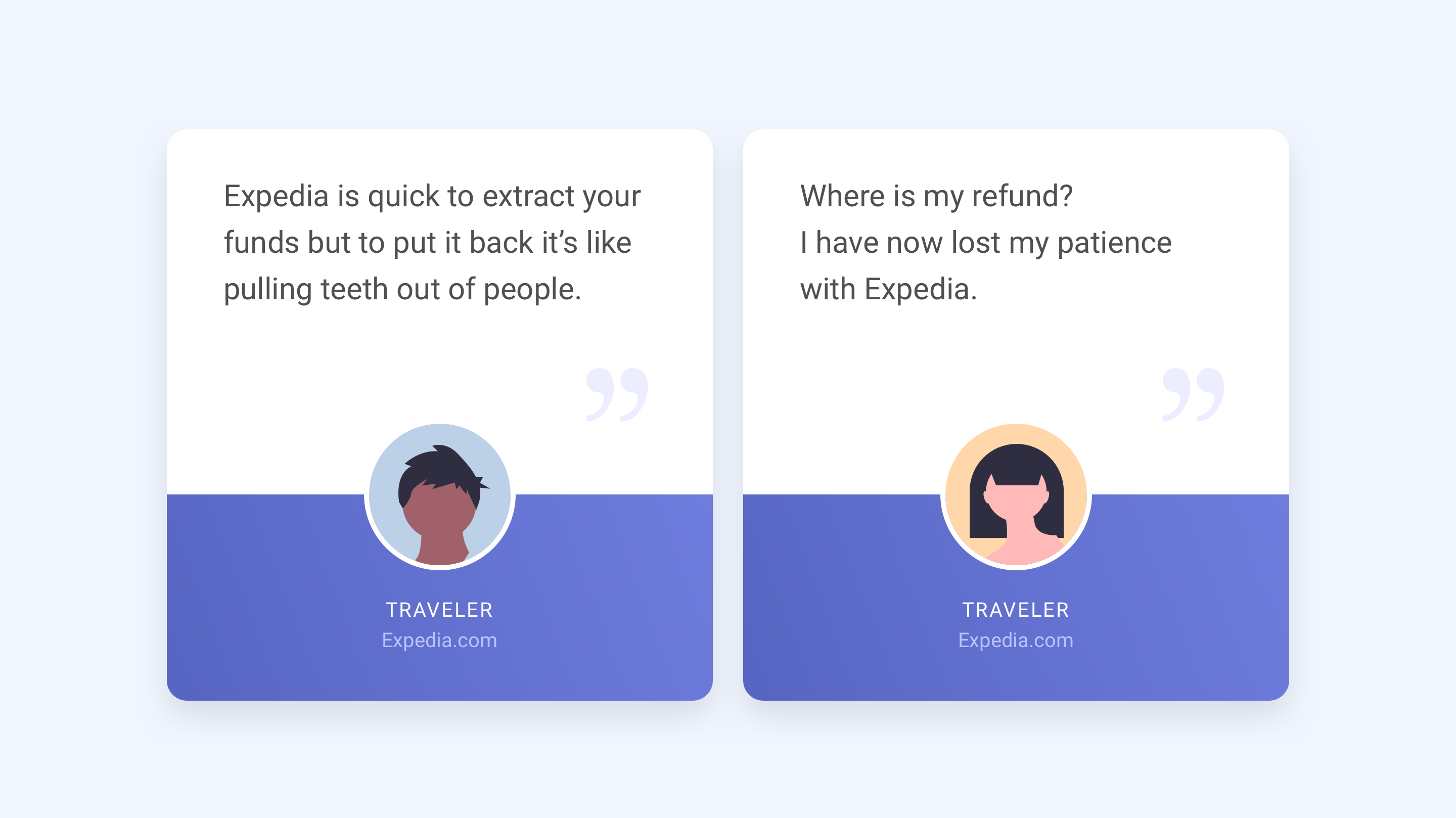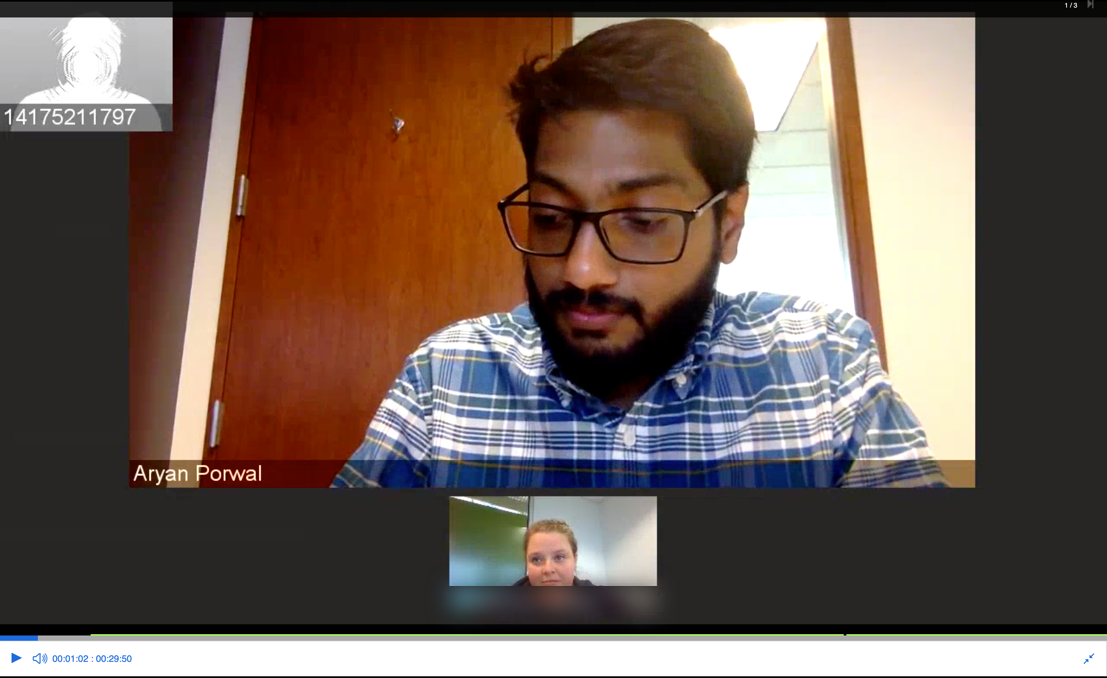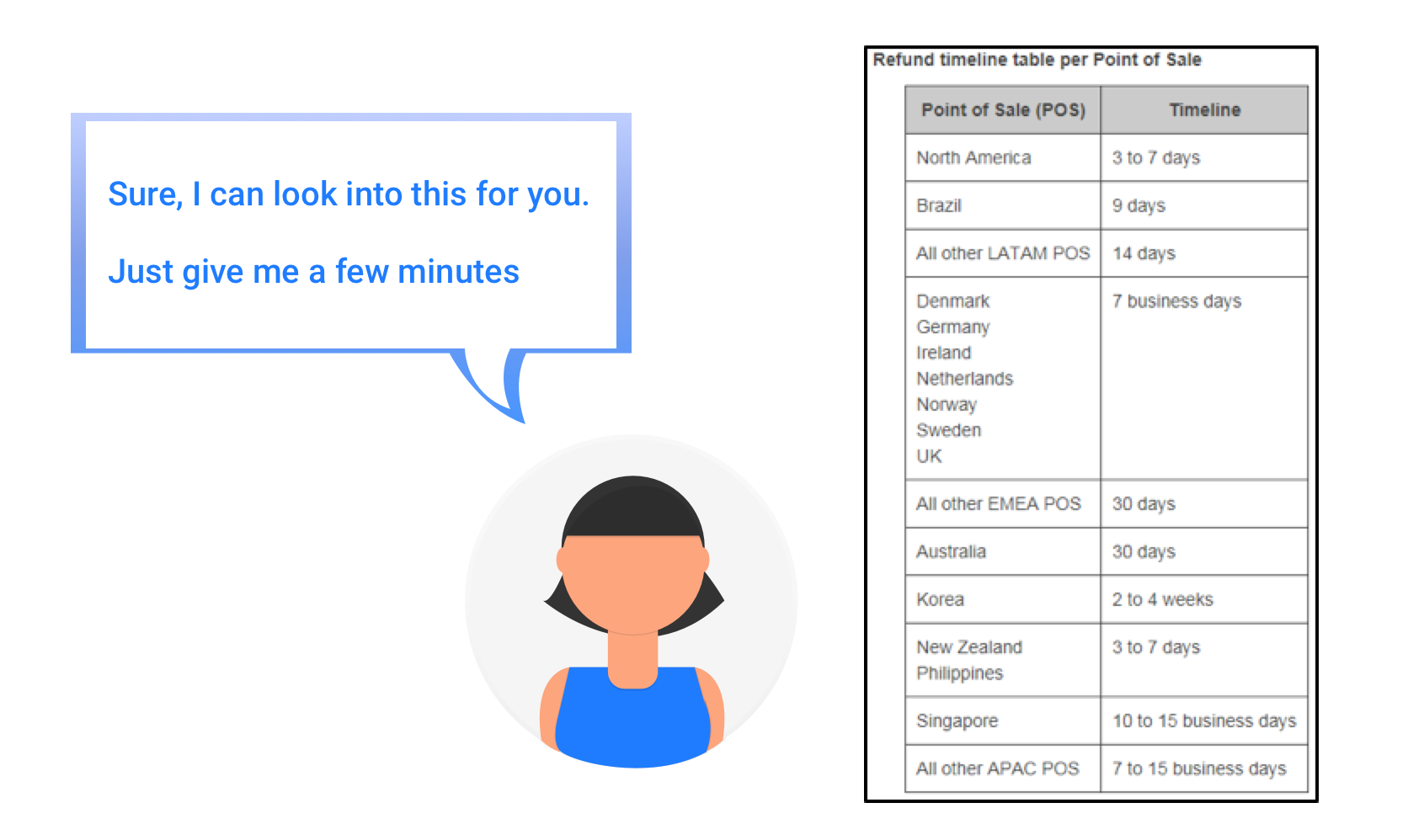Where’s my refund?
A Design Case Study
2017, was a year of transition for Expedia Group’s customer service experience. Aggressive goals were made to become as effortless as possible to resolve Travelers’ pain-points. This is a story of how I turned the top pain point of travelers for all brand partners into a fun and interesting one by designing a refund tracker.
The tracker empowers Travelers to track their refunds with status information and remove the need to contact the customer care representative for any questions.
To comply with my non-disclosure agreement, I have omitted confidential information in this case study.

Current State
If there is a refund as a result of cancellation or changes to a booking, the traveler is shown a generic message and have no visibility into the status of their refunds. The only way to get more information is to contact a customer care representative.

The information and messages displayed are very generic and don't help in providing any useful information.
The screenshot shows the message traveler sees while canceling the booking. Since it loosely defines the refund timelines, there is a lot of anxiety that builds up from the time of canceling a booking to getting the amount reflected in the bank account.
This screenshot shows the cancel confirmation page which is shown in the cancel flow after the booking has been successfully canceled. The messaging here also does not provide refund timeline information.

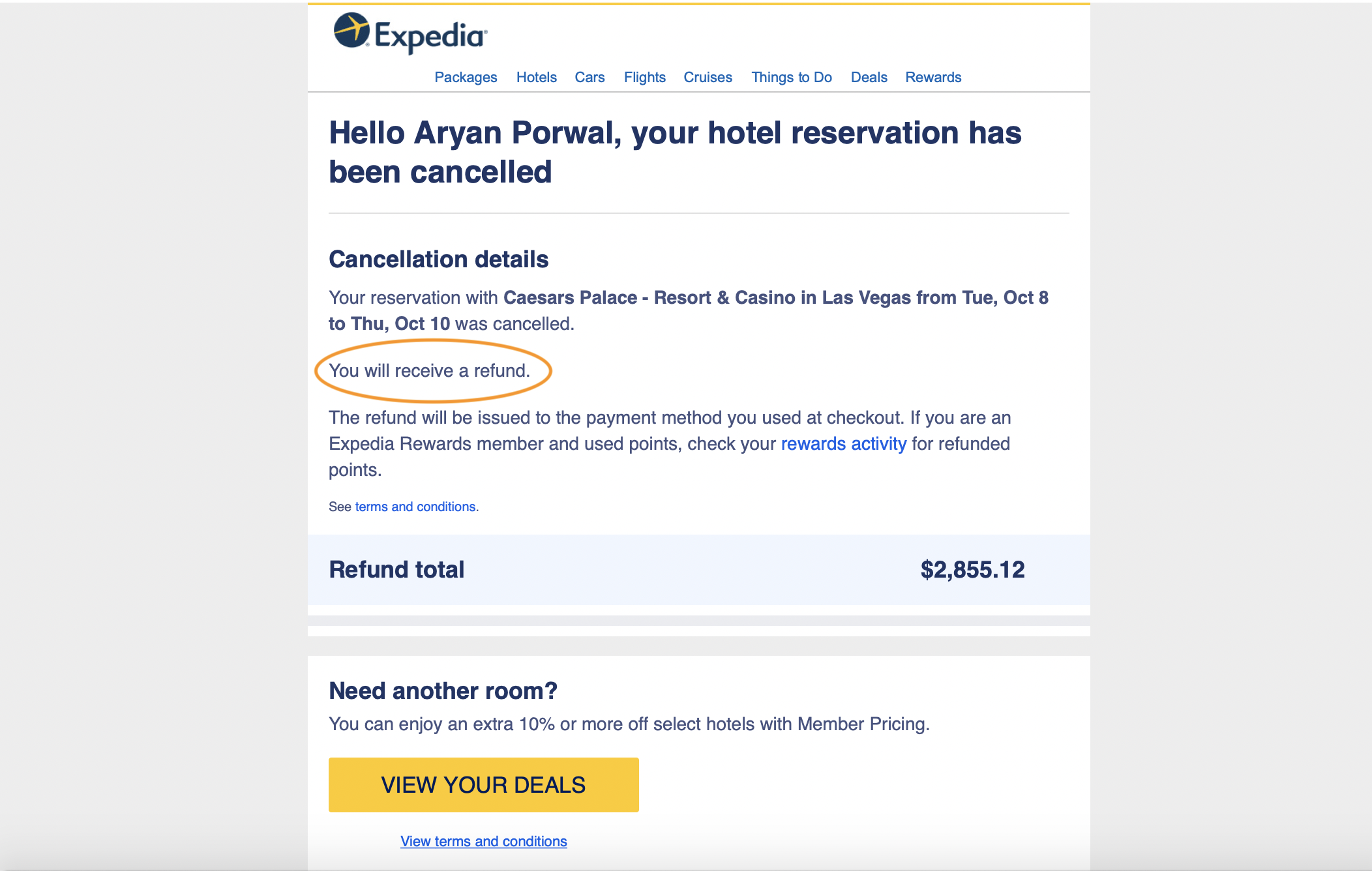
Cancelation email with a refund information message after a hotel is canceled.
The Challenge
Where’s my refund?
Refund issues are a top DSAT driver in the Dissatisfaction Analysis for all brand partners within Expedia Group. Travelers don’t have visibility into the money we owe them or the status of their refund and therefore have to contact an agent with any questions. This leads to a lack of trust, increased frustration and contact propensity.
Every day, 45,000 refunds are processed for our Travelers, with an average cancellation amount of $500. Once a refund is initiated, our Travelers are left waiting for days, or even weeks. Many of them would call us to ensure they will get their refund. In 2016, we handled 1.8 million calls on “Payment Issue”, leading to an operating cost of $7.3 million. Meanwhile, the NPS (Net Promoter Score) of “Billing & Refunds” is -11%.
Customer feedback
- Expedia.com: -56 NPS for Hotels refund cases (lowest NPS within all Expedia Group brands)
- Hotels.com: In top 3 “extremely negative experiences” with only 29% of customers satisfied.
Hypothesis
By making the Travelers' refund details more robust and accessible, Customers anxiety and refund call propensity will decrease. This will save us money on operational costs as well as improve NPS for refund issues.
Benefits
- $1.6 - 2.0 million in reduced operational spend (contact avoidance and call efficiency)
- Repeat business through NPS improvement. Promoters who put quick refund in their CSAT comments do 460% more gross bookings with us than a detractor who puts refund in their comments.
- Chargebacks impact: $3.25 million in chargebacks are filed where the refund is before the chargeback and the amounts are different. These cannot be caught with reporting and must be manually assessed. It was believed a portion of these are from misunderstandings around refund status and timing (26-33%) and could be prevented by providing Travelers with easier access to their refund status.
My Role
I led the design of the refund tracker experience in 3 phases as part of a small team alongside 2 Product Managers, 2 Content Strategists, and 2 Designers. I led the UX work and was responsible for the research, project planning, design strategy, interaction, visual design and specs of the experience. I designed across and collaborated with three platform designers and their PM partners to translate product features.
The Discovery
Why does Traveler contact for refund status?
I was curious to know why does this issue even exist. What is driving this behavior and contact? To understand factors leading to a contact related to refunds, I started looking at past data to formulate some patterns.
Some of the questions I was trying to get answers were:
• What is the customers’ journey to the point of checking the refund status?
• Do customers with specific credit cards tend to call more?
• Is there a correlation between billing payment type (Visa, AmEx, etc.) and contact propensity?
• Does the country of the property have any effect on the contacts?
• Does the refund proportion (full/partial refund) affect contact rate?
I have intentionally not revealed confidential data here.
Came across some interesting insights and the main driving factor that leads to a refund check is Anxiety. These are the key insights that define the reasons for the concern.
Lack of trust: Travelers don’t have visibility into the status of their refund and therefore were anxious about the time it’ll take to get the money in their account. In addition to it, verbiage of status/confirmation messages was making it worse like “We’ve initiated your refund. Refunds take five to seven days to arrive in your account, but can take longer, depending on your bank”. Travelers want immediate assurance.
Amount sensitivity: Complicated rules around cancellations and changes makes it difficult to have confidence in the final amount. E.g. “Cancellations or changes made after 11:59 am (property local time) on Jun 30, 2019 or no-shows are subject to a property fee equal to the first and second nights rates plus taxes and fees.”
You took it, you’ll give it back: Expedia works as a travel aggregator and passes on the money collected for a booking to its travel partners like Airline, Hotel or Car rental companies, etc. From a customer’s standpoint, since Expedia collected the money at the time of purchase, they expect to get all their questions answered from Expedia which is sometimes (or many times) not the quickest way to get the problem resolved. If the amount is already credited in the partners’ account, it’s more or less out of Expedia's hands at that point.
Data showing the percentage of customers contacting after refund is initiated.
Traveler's comments collected from App store and Website reviews
Collectively these issues result in angry, frustrated Travelers who think we don’t have our act together. By addressing these, we can gain back our credibility.
Introducing
The Refund Tracker
With Refund Tracker, you never have to worry about your refunds anymore. Automatically track the refunds you're expecting.

Redesigned Cancel
See and track your money up-to your bank account
Refund tracker is a step-by-step process indicator. Travelers can see and track their money up-to their bank accounts.
Right information at the right time
Easily find information, tracking numbers, expected dates, and amount details. Expedia does the tedious work for you and brings you the information when you need it.
Updates for every moment
Set up email and text alerts so you don't need to be anxious about where your money is.
Proactive rather than Reactive
Expedia wants to proactively communicate and give you resources to track your money.
Reducing anxiety through visibility
Expedia informs you of your refund status in an easy and understandable way with exact or estimated timelines.
How we got there
The Approach
In favor of speed to market, we were tasked to design and build by leveraging the existing infrastructure to get a solution sooner and save operation cost.
Mapping out the user’s emotions was key for the emotional state we were aiming to design for. We used experience mapping techniques to visualize and communicate the Travelers end‐to‐end experience. This allowed us to represent users' pain‐points and identify where we needed to focus our attention.

The Vision: Design for Confidence
I wanted to build a solution that is
• Proactive
• Comprehensive (one-stop for all information)
• Real-time
• Easy to understand
• Assuring
Visualizing the end-to-end

Chalking out the plan
I worked on the roadmap of the project in collaboration with the Product Manager. We broke down the project into 2 main phases based on the two target users of the feature – Agents and Travelers.
Phase 1
Richer information & processes for agents
Laying the groundwork and investigating how much data is available using the existing infrastructure and determine if there is a need to build new systems. Working with a different org in our division that specializes in payment solutions and enable refund tracker for the customer care agents.
Phase 2
Empower the traveler to know where their money is
Using the laid foundation to enable the refund tracker on traveler’s side. The plan was to build and launch on Customer Care Phone IVR (Interactive Voice Response) system, Desktop and Mobile web experiences first to monitor the system performance, metrics, etc. and also get the infrastructure ready for the next phase.
Phase 3
Extend the built functionality to iOS, Android, Emails and, Bots (chat & voice).
Phase 1
Agent’s experience
Refund status is a complete mystery to Travelers, requiring them to contact us. Agents do not have the right status information to assist Travelers effectively. I wanted to enable agents to be experts. Also, for the tough scenarios like chargebacks, payment processor errors, refund ETA, etc., our agents should reflect as travel specialists.
A day in the life of an agent
It's always an eye-opening experience talking to an agent or visit a contact center. To gain more insights for this project, I planned and conducted remote interviews with them to understand the process from their perspective.
Remote research study with agents in the contact center.
Came across these key insights:
Escalation: Refund status information was not readily available to all agents. Payments & Refunds investigation required an escalation to a higher-tier agent so that they can use a few external tools provisioned especially to them and research the situation. It was more painful for Travelers since they have to sit in a queue to get connected to a higher tier agent and more expensive for business because it’s expensive to use higher tier agents time and skills.
Need for richer information: Some of the key information like ARN (bank reference number), Payment processor details, Pending Authorizations, Chargebacks, etc. were spread across different tools and agents expressed a desire to consolidate at a single place to make it easier to parse and get the full picture instantaneously.
Show me the money: There is no standard refund timeline. The time it’ll take to get money reflected in the bank account depends on a variety of factors like the product you purchased, Payment Processor processing the payment, time taken by your bank, Region, etc. With payment transactions also comes a myriad of compliances which may make the information completely inaccessible. It was turning out to be challenging for agents to remember all of this, research and also continue the conversation with the Travelers.
Image showing the informarion agents use to convey the generic refund timelines because of lack of specific data.
Defining metrics
Working alongside Product Managers Lily Dias and Kim Jin, we came up with hypotheses and metrics for each phase to help us define success and monitor the performance. For this phase, the main hypothesis was-
Hypothesis 1 - First call resolution
Agents can resolve Travelers’ problems quickly and effectively if they have the right information in front of them. Travelers who talk to such an agent will not contact again for the same problem.
Primary metric: First call resolution (FCR) + Prevent escalations + Reduction in 3rdParty Tool usage
Solution for scalability
This phase also allowed us to investigate how much data is available using the existing infrastructure and determine if there is a need to build new systems. It became clear very quickly that to reduce the dependency on external tools and have more control over data, we need to stitch the scattered information together. We brought the shortcomings of the current process in front of the Global Payments org in my division and started brainstorming ideas that can help us get closer to our vision.
Quick IVR Test
We also put together a quick IVR test of the new feature to prove the value and justify ROI (Return on Investment) which helped tremendously in negotiations with the other org. This quick test collected early data, validated the concept and measured impact. Working with Dina Trageser (Content Strategist), we changed the messaging on IVR to address basic questions, provide self-service options, and save agents for the true challenging problems and not the updates.
In the IVR test, giving Travelers a refund confirmation readout deflected 20% calls.
Test Details
• Group A (Control): Generic Refund Timing
• Group B: Traveler verifies for self-service
• Sub-group 1: Traveler does not verify → returns to control messaging
• Sub-group 2: Traveler verifies → receives refund readout (amount, date issued) and ability to resend refund receipt
• Success Criteria
• Primary: 5% increase in IVR abandon rate after refund details are read
• Secondary: Callback rate maintained

Generic Refund Timing Messaging
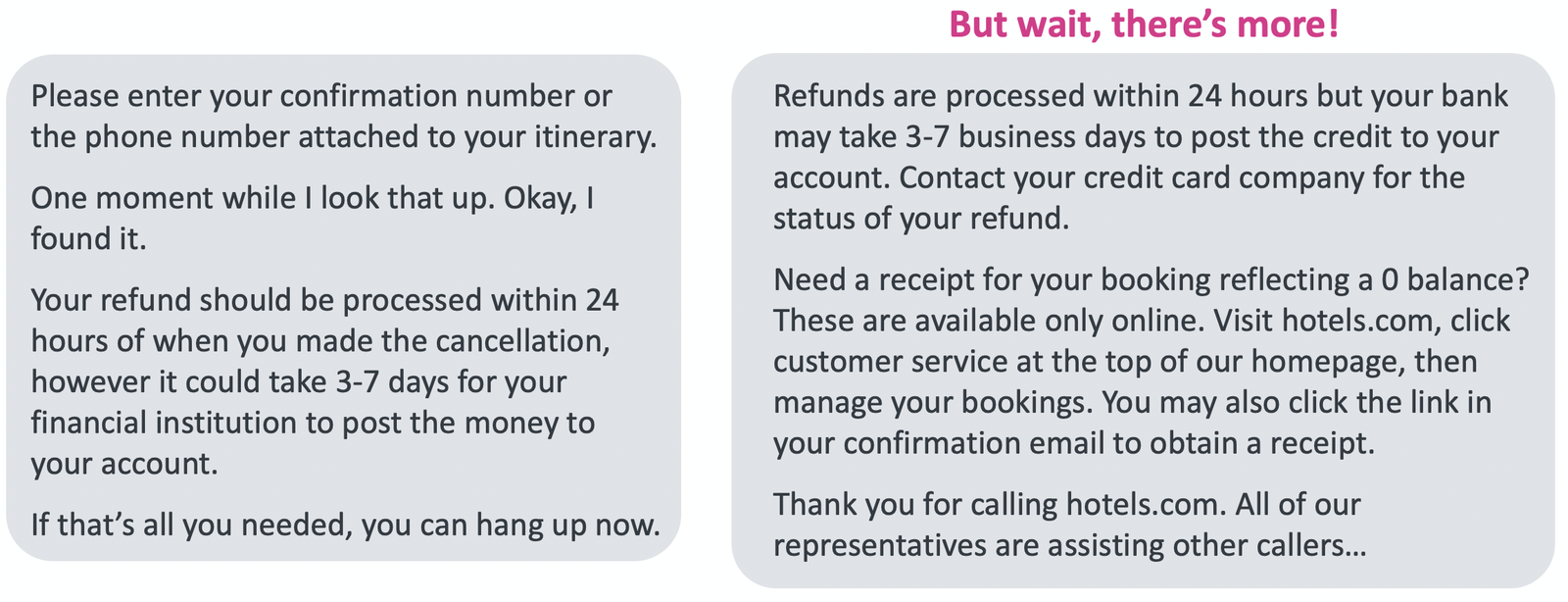
Existing refund timing message in Interactive Voice Response (IVR) System
Interactive Voice Response (IVR) existing audio message
New refund test messaging

New refund timing message in Interactive Voice Response (IVR) System
Interactive Voice Response (IVR) new audio message

What this tells us?
Where’s My Refund really is all about reducing anxiety!
After two weeks of intensive brainstorming, negotiations and data reviews, a decision was made that Payments org will develop an API which will provide details of any transaction across Expedia for consumption. We’ll become the first Guinea pig to consume the information and show it in the agents' application.
The Design Framework
Setting the Design Direction
I took a top‐down approach to define the overall structure of the experience. Working backward from North Star helped to formulate a strategy and envision the future but also kept us focused on the first phase. Sketching and generating stacks of ideas about the arrangement of UI on different form factors, functional and data elements, and interactive behaviors helped define the vision.
Building trust through transparency
As the other team was getting the API ready, I started working on the design framework in parallel. As a North Star, I envisioned that the user should develop high level of trust with Expedia and there should be no anxiety for refund status? The only way we can establish this level of trust is by communicating the right information at the right time and gain back our credibility. We decided to aim for it in all the phases of the project since there was a need to gain trust and credibility on the agent side as well.


Refund tracker displayed in agent application's billing history.
Build once deploy everywhere
Looking at the North Star we wanted the information to be scalable and easy to be reused on various other channels in the next phase, we started planning for it from the get-go. We decided to build the tracker as a standalone widget so that it requires minimal work to launch it on various platforms like apps, desktop, emails, chatbots, etc.
Structuring the experience
We wanted to retrieve refund transaction data and translate it into Traveler-friendly language. There are multiple steps money goes through in their journey back to the bank account but I didn’t want to overwhelm the user by showing all the steps. I started identifying the main 'plot‐points' in our scenarios and crafted the best way to conceptualize and structure the proposed content and functionality. After a lot of iterations, the tracker was slowly coming to life with three main steps. These three steps provide the right amount of easy-to-understand information and help to build trust and credibility.
When a refund is requested, the first step ‘Refund started’ kicks-off. In the second step, Expedia processes the refund. Depending on whether Expedia or the Travel Provider is the merchant of record, the refund is then handed to the Bank or the Travel Provider in the third stage. When the bank/travel provider finishes processing, the money gets back to the account. Throughout the whole process, our Agents and Travelers are kept informed and assured.
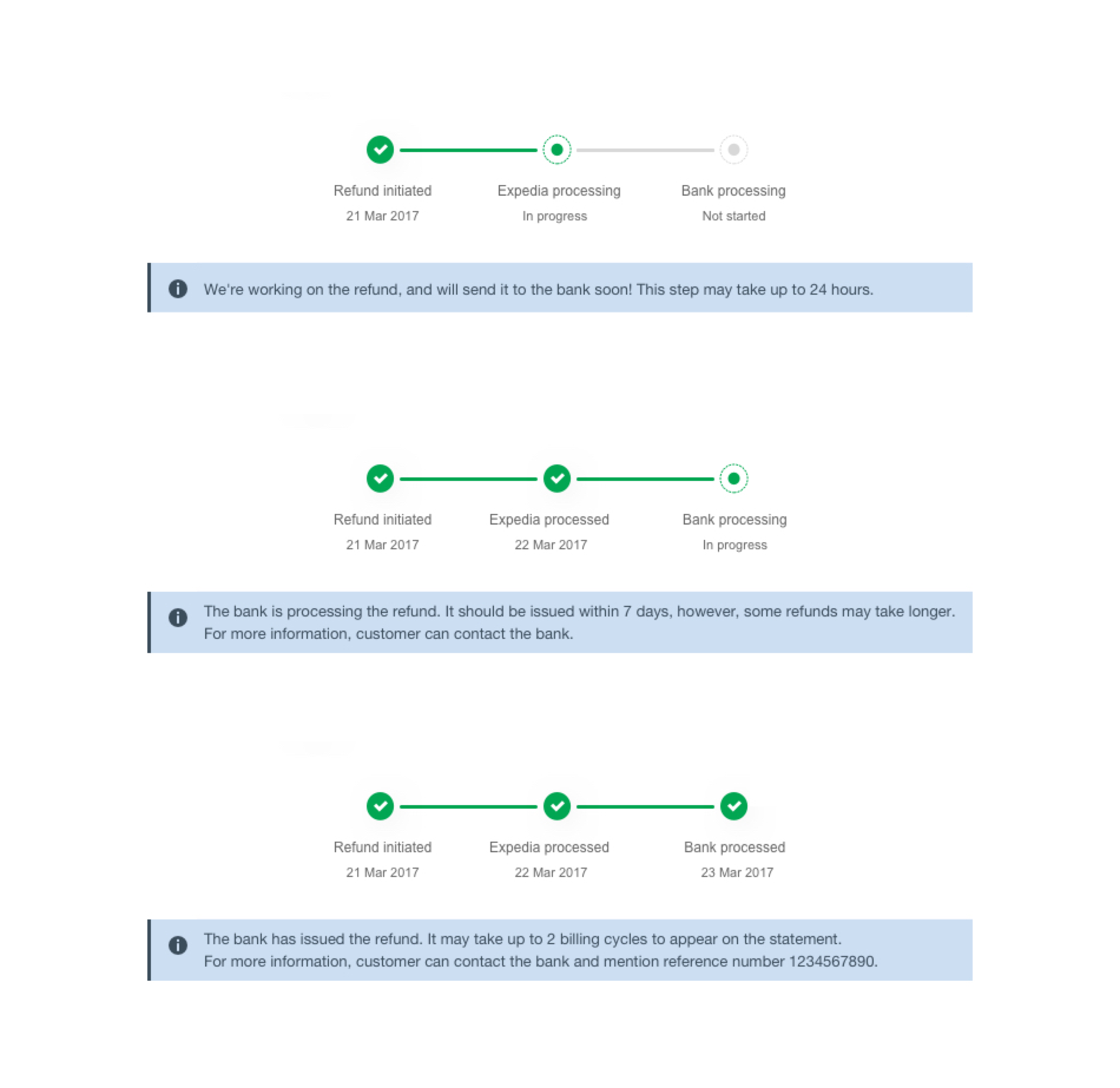

Phase 2
Traveler’s experience
The hypothesis and metrics we came up for this phase were:
Hypothesis 1 – Higher Contact Deflection
Travelers who view the refund tracker may contact an agent lesser compared to those who haven’t seen the tracker because of the refund information available to them.
Primary Metric: Contact Deflection Rate
Hypothesis 2 – Lower costs associated with calls
By viewing the refund tracker, Travelers with recent refunds may be less likely to contact an agent which may result in lower costs associated with these calls.
Primary Metric: Cost for “Refunds and Billing” calls
Secondary Metrics: AHT, NPS, SAT, FCR
Hypothesis 3 – Lower Customer Effort Score
Since customers can access their refund status easily, the CES (Customer Effort Score) would decrease.
Primary Metric: CES (Customer Effort Score)
The plan worked out
The Build once deploy everywhere strategy of Phase 1 was showing a positive impact. Since we did most of the heavy lifting already there was very little work needed to turn the feature on for the Travelers.

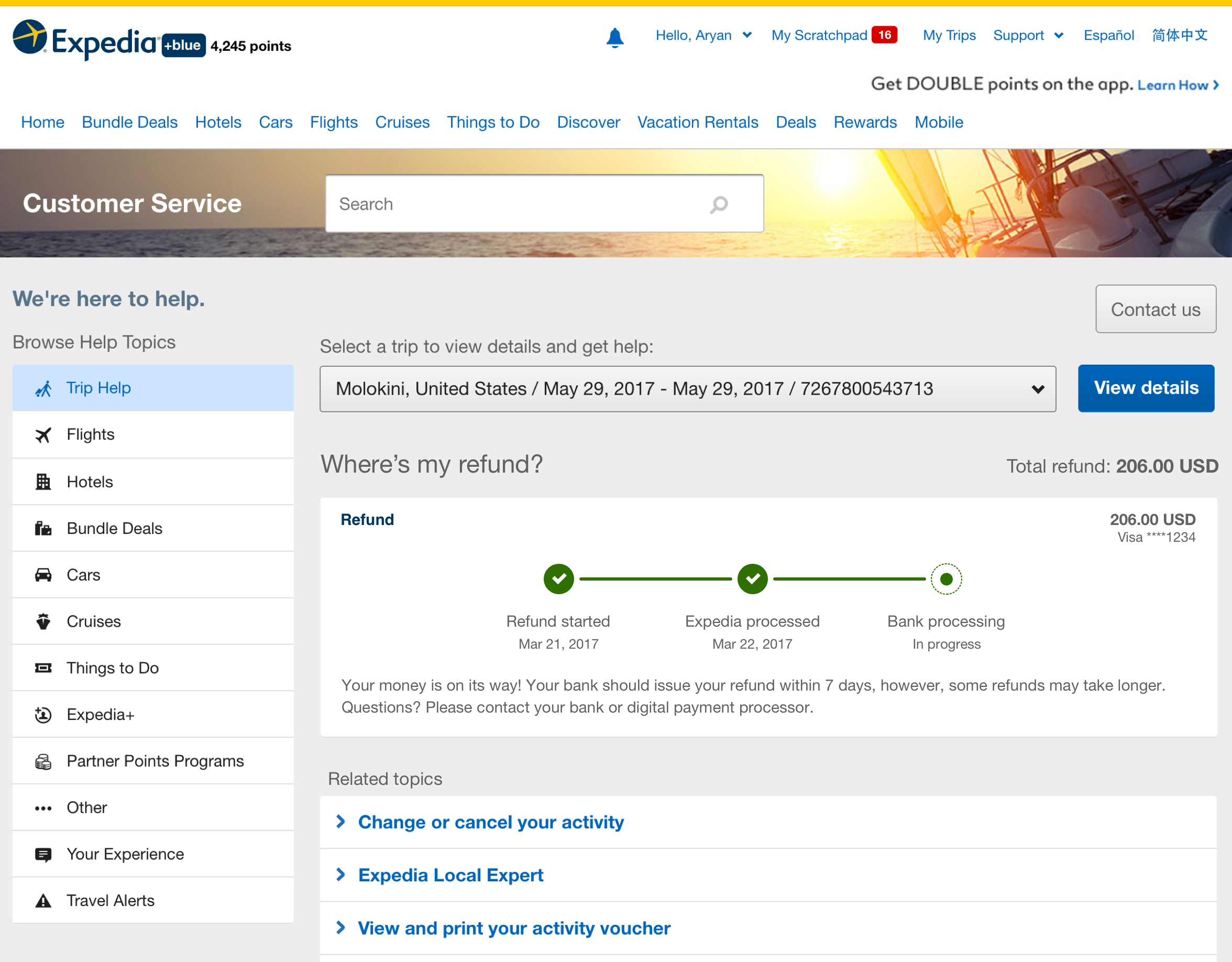
Keep it simple
I streamlined the information more to not reveal complex information to Travelers. It might be okay to show the extra information to agents as they know the intricacies but showing simple and reducing jargon helped us to reduce the information overload and confusion.
Recap Refund Amount
Expedia knows how much is owed to you and where the money will go.
Provide refund information and visibility in the process
Expedia informs status because they care too!
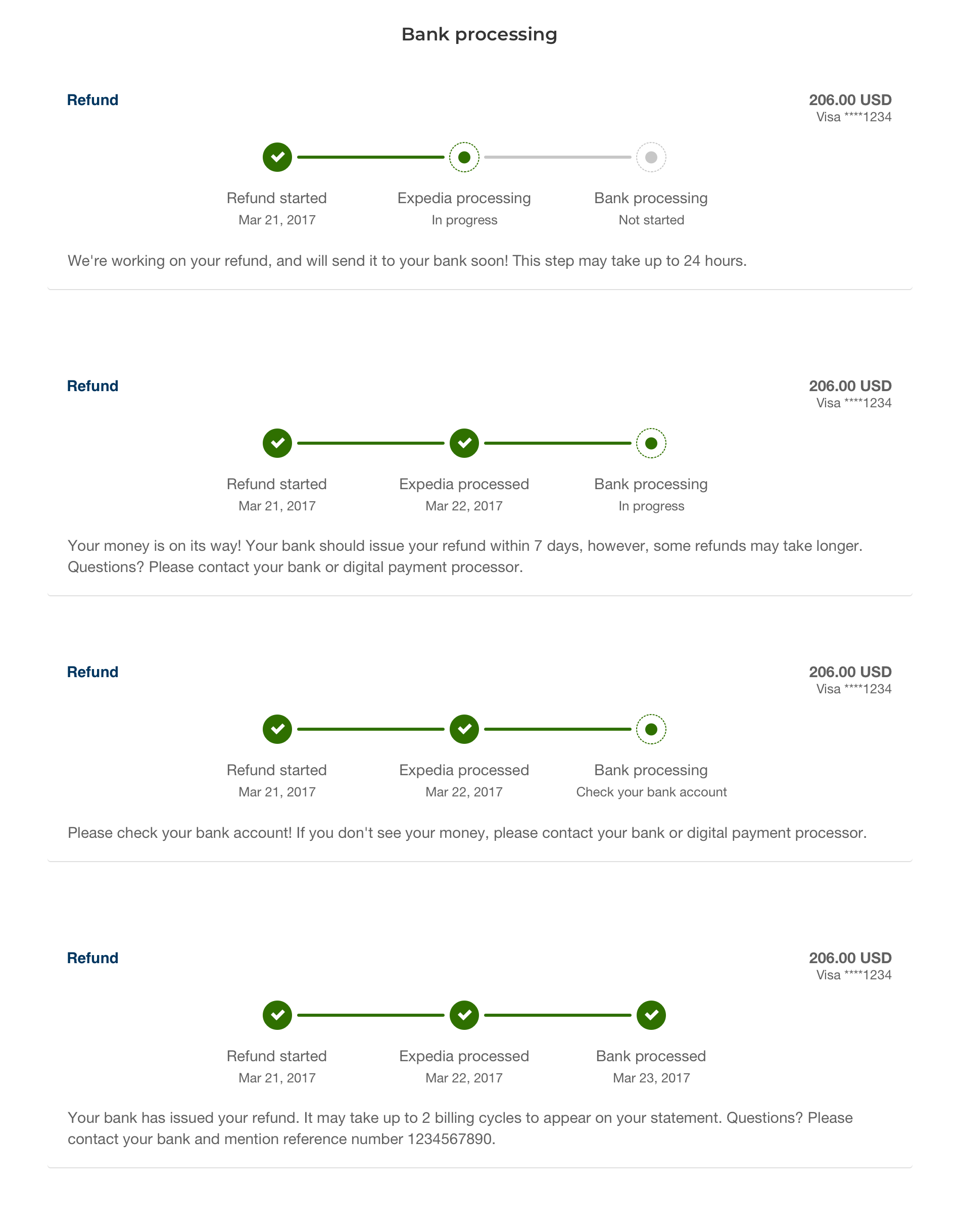
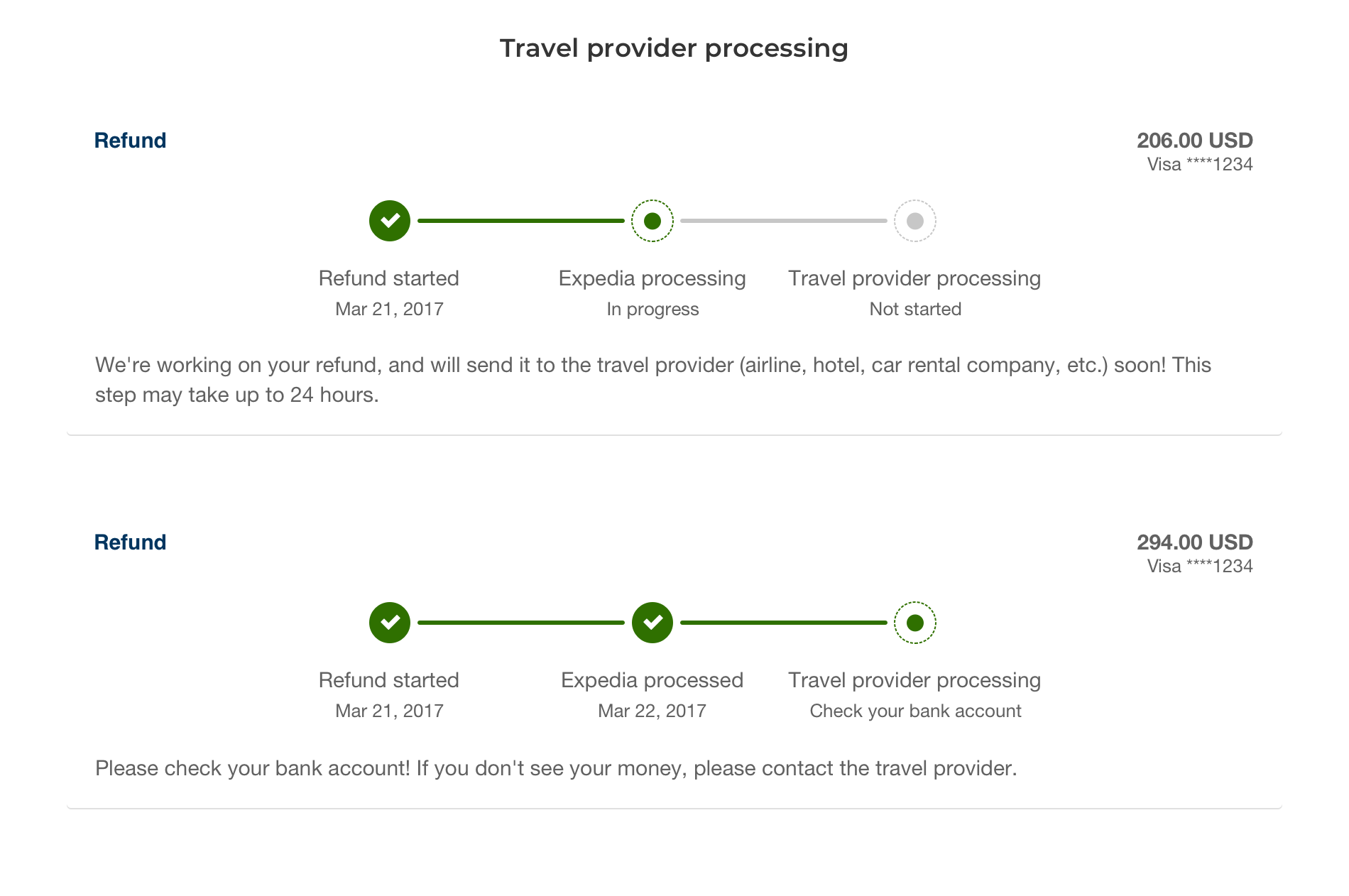
Motion Design
I decided to use Apple's Keynote to communicate the interactions and transitions. The transitions helped to strike a balance between reinforcing context and creating an engaging and compelling interface.
Unfortunately, the motion design work didn't make it into the final implementation because it was considered 'cosmetic' and de‐prioritized for Phase 2. It was an acceptable trade-off seeing the timelines and resource allocation. Although I was quite vocal about the importance of transitions in helping the user maintain context and giving the positive perception of motion or ‘money is on its way’ indication, it was decided to re‐prioritize them in Phase 3.

Results
Designed for Confidence
The interface design strives to be confident. Working with Michael Dwyer (Content Strategist), we opted for clear, readable information — choosing messages with clear concise information to increase credibility. It does not contain unnecessary elements. The design is uncluttered, clean, intuitive and well-spaced. All our design decisions help to exude a sense of confidence in the design.


Phase 3
Future Enhancements and explorations
This phase will extend the functionality at appropriate places to increase the discoverability and make the information more readily available in context. We are actively exploring placement opportunities with:
iOS App
I partnered with Rachel Kozemczak (Designer) and Sarai Dominguez (Content Strategist) from Expedia.com design team to push the designs in the iOS app and make it even easier to access in-context when the booking is canceled. This will help in the discoverability of the widget even better than the previous implementations. The feature is not yet released at the time of writing this case study and is scheduled to launch in late 2019.
Emails
Having the tracker in Change/Cancel emails will further increase the discoverability fo the widget and will help in adoption and further call deflection.

Bots
This effort is part of a shift at Expedia Group to think more in terms of Platform rather than Product and to emerge as The World’s Travel Platform. My organization is making a big bet on the Virtual Agent Platform that can do all the heavy lifting in self-service and customer service space for our travelers.
I am leading the effort and further exploring and partnering with Kai Tamulonis (Designer) and Kim Jin (Product Manager) to use the same widget in the virtual agent platform. This requires a big design shift for the posture of the experience. The challenge is shifting from traditional web pages to a conversational interface. Instead of designing for a particular brand, we are designing a flexible system optimized for configurability and scalability. The feature is scheduled to be released in late 2019.
Read more about the virtual agent platform case study.
Reflections
Am I proud of the state of tracker I released? I’m partially lying if I say I am. Let me explain why.
I value simplicity. I aspire to make people happy by designing experiences that just get out of the way. Craftsmanship and carefully thought out details are important to me.
At the time of the first few releases, there were a lot of other features we were not able to get to. Features I consider really important for a carefully thought out product. I knew exactly which critical aspects were missing but these items will require further collaboration from other teams and organizations within Expedia. Some of the key items were-
Refund timeline prediction: Correct timelines for when will I get the money in account.

Subscription for refund status update via text messaging.

Bank & travel providers’ contact information if the user has to further follow-up with them to track the money.
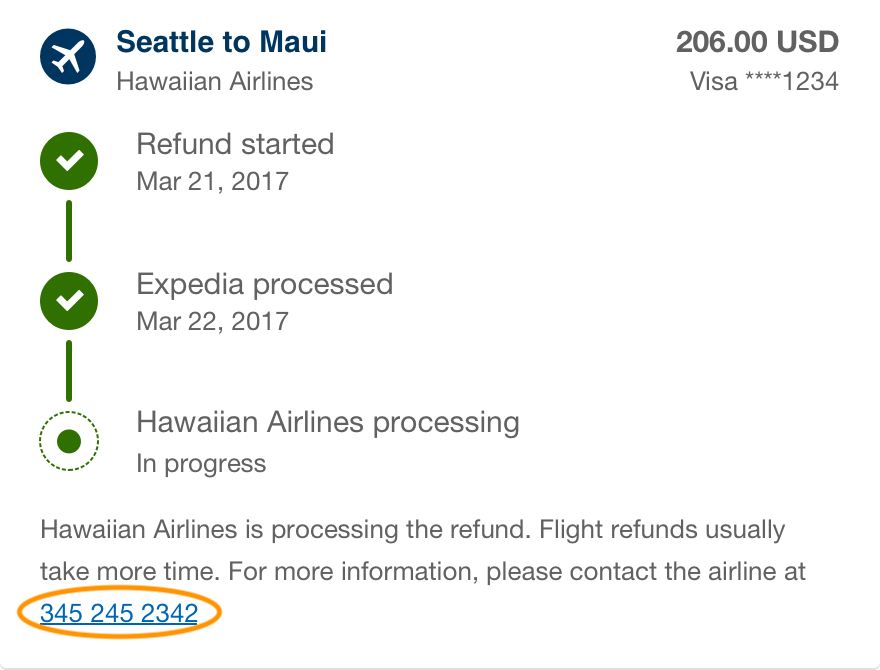
More accurate product details.

Having said all of that, I am proud that the team is in a better position after this effort. Launching this feature exposed how badly things were broken and the amount of effort we have to put in to fix things. Great design takes time and effort.
Next Project
Case Study ?


